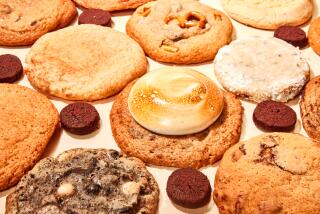Stress baking? Then you need to try this calming new bread technique
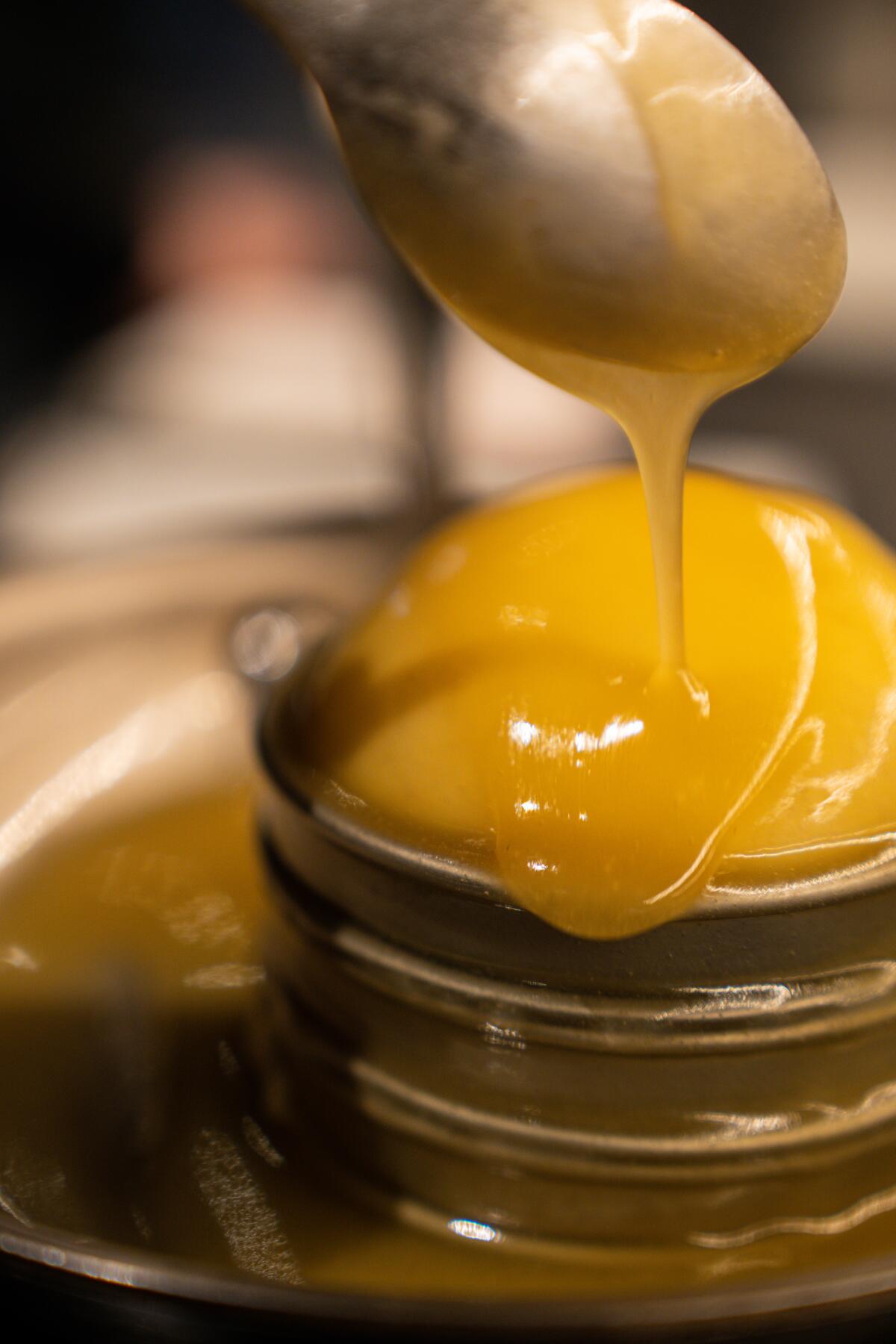
Pastry chef Dyan Ng’s pan-roasted honey brioche isn’t just new, it’s revolutionary. She created it for the brunch menu at Auburn “to give people something different that they’ve never tried before.
“As a cook, I don’t want to be showy, but I always want to do something different.”
Ng cites Auburn and its surroundings as her inspiration. When Eric Bost was opening the restaurant on Melrose Avenue, he called Ng, then the pastry chef at Michael Mina’s restaurant in Baltimore’s Four Seasons. Bost said, “Hey, I’m looking for a pastry chef. Do you know any?” Ng immediately replied, “Yeah, me, chef.”
This caramel-coated brioche has the yeasty depth of sourdough with a buttery, almost custardy richness.
Ng was excited for the opportunity to return to Los Angeles. She had moved to L.A. from the Philippines as a child and stayed to start her culinary career after high school before going to Las Vegas to cook in the kitchens of Alain Ducasse, François Payard and Guy Savoy. Those years of intense training in French techniques gave Ng the skills and freedom to create original takes on classics, like this brioche.
Ng first developed a formula for a milk-less brioche extra rich in butter and eggs so that it wouldn’t just taste like pain au lait. And although the brioche was delicious, she said, “It was just a delicious French bread.” She then tried to caramelize the top of the loaf with honey butter while it baked, but wanted the bread to be more tender all the way through. So she decided to try cooking the dough completely on the stove while basting it with honey butter.
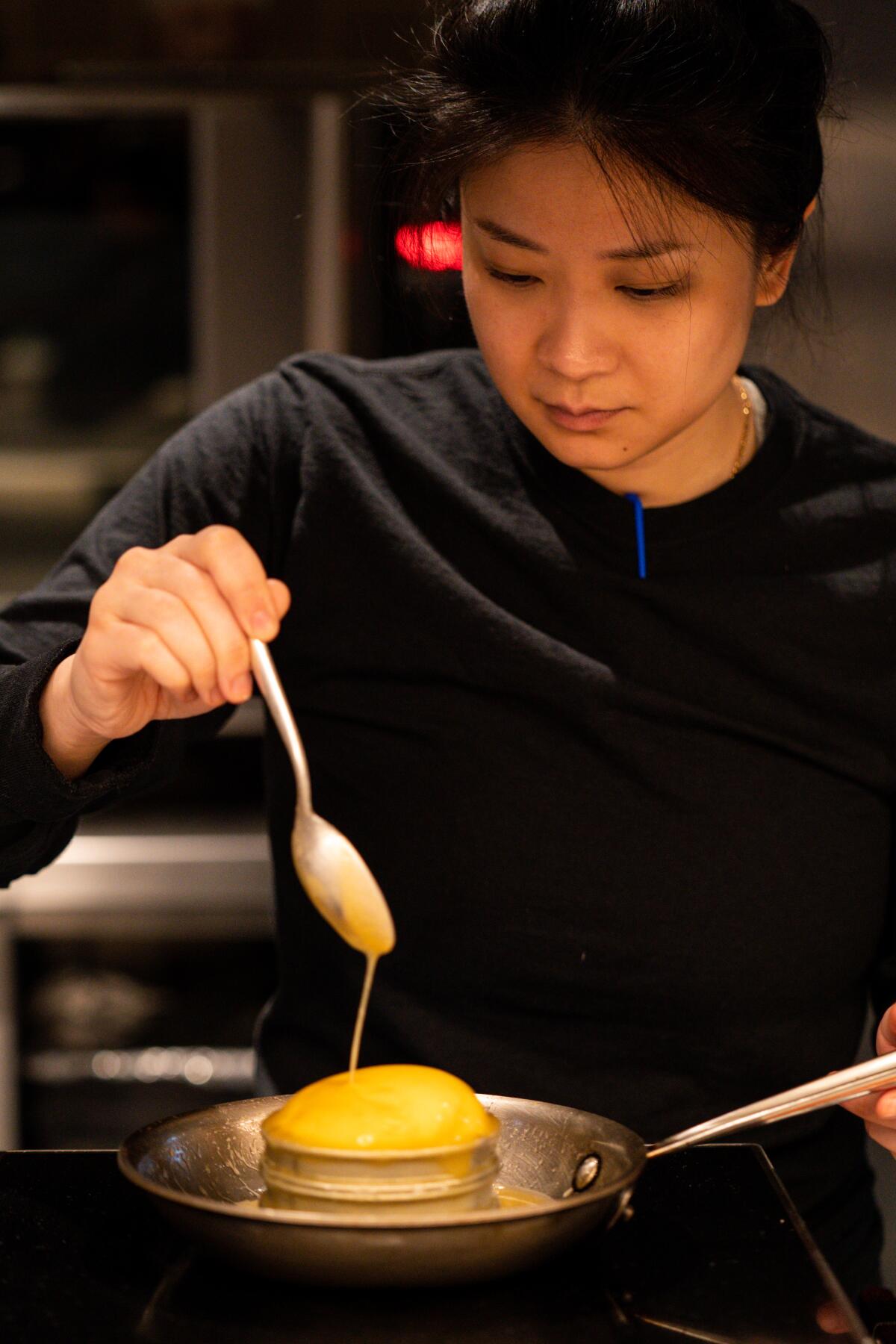
“I hadn’t seen this technique before, but I can’t say it hasn’t been done,” Ng said. “Honestly, I didn’t think it would work, but I nailed it on the first try.”
Not content with simply nailing it, Ng went on to perfect it. To achieve just-right tenderness in stovetop pan-roasting while creating layers of flavor, Ng landed on putting the rich dough through five stages of proofing over three days.
I didn’t know any of that when I first tasted it. I just knew I wanted to find out what Ng was doing throughout brunch service. My seat faced Ng’s pastry station and I couldn’t stop staring. Framed by the floor-to-ceiling glass door between the open kitchen and dining room, Ng stood over a portable burner and kept swirling a skillet with a small golden dome peeking over the lip of the pan as it slid around. Now and then, she’d spoon sauce over the slowly ballooning top with the circling arm swoop of a meat cook basting a steak. Even from my perspective some 20 feet away, I could see Ng’s focus and calm. I wanted what she was having.
The brioche itself, yes, but also the process of making it. The final step happens tableside, when Ng pours honey-butter caramel all over the deeply browned brioche. Over that sugary aroma is a sourdough tang and the kind of cultured butter scent that borders on cheese. It’s all very confusing until you take a bite.
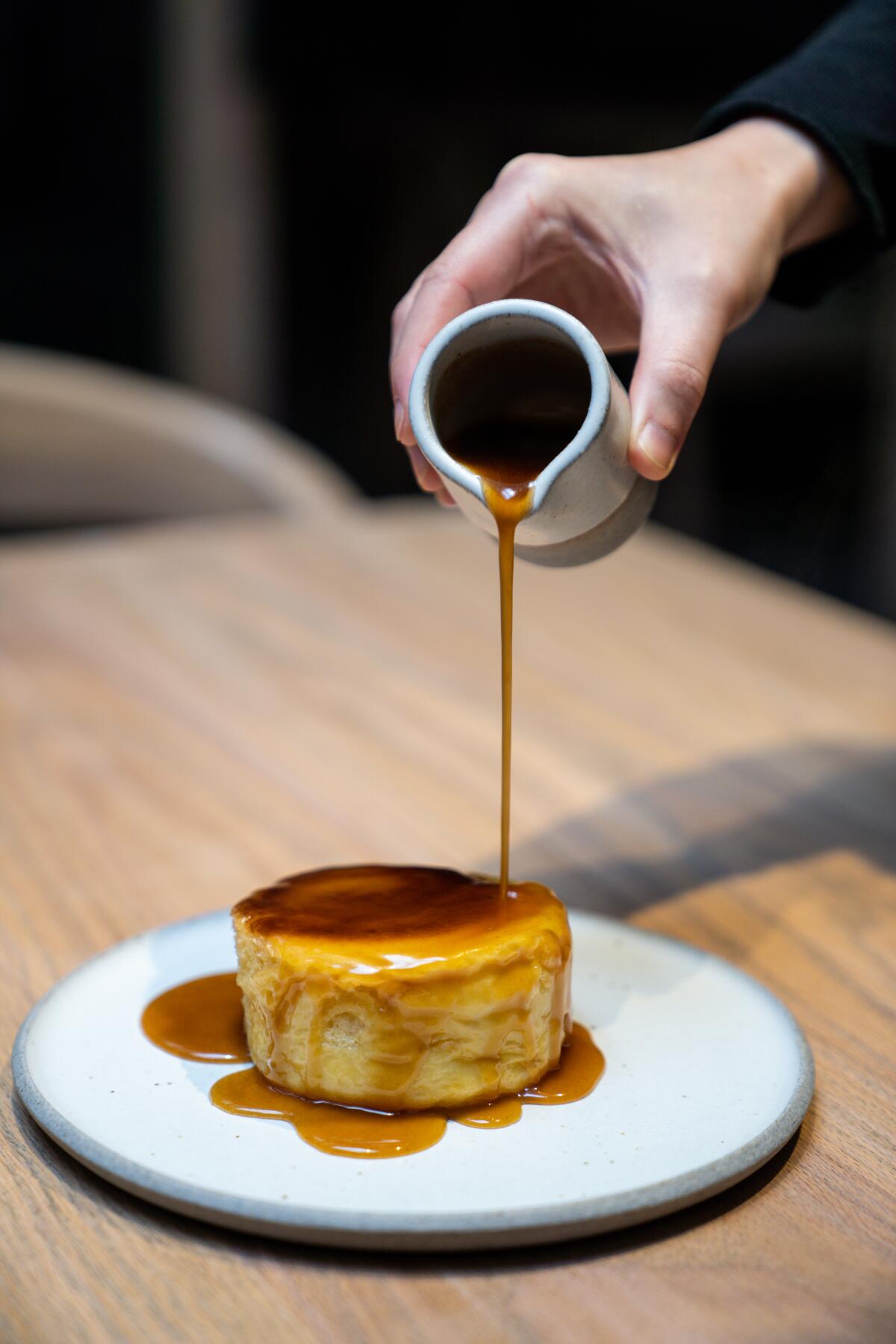
It has the yeasty depth of sourdough without the self-righteous austerity, the buttery richness of brioche with an almost custardy eggyness, the welcome bitter edge of dark caramel seeping into the bread and running all over the plate.
Ng’s years of mastering French pastry are clear in this brilliant technique that’s actually easy to execute even if it takes days from start to finish. The genius is in its simplicity. Her technical skills translate into just-right proportions of five ingredients that yield foolproof dough, and the two-night proofing ensures the bread stays tender on the stovetop while holding its shape and caramelizing to a dark brown.
Testing this recipe at home over the weeks that the coronavirus changed this city and country, I found that it not only worked perfectly every time in every variation but also provided a welcome peace. At each non-proofing stage, this brioche demands your attention and rewards it with sensory pleasure. The dough slaps the mixer bowl with a steady low thawp, thwap, thwap. When you gather the soft mass into a ball, its silky stretch delivers a deep tactile joy. So too does cutting and shaping the cool smooth dough into rounds. You can inhale its yeasty scent whether it’s baking or cooking on the stove. With the latter, you enter zen mode, watching the dough slowly poof as you baste it with honey butter that bubbles and darkens into caramel. You have to be present in every sense. In our current state, it’s a wonderful place to be.
Ng is back in Auburn’s kitchen preparing desserts for its take-out meals. She’s worried about her family in the Philippines, but she’s grateful to be in the restaurant, which feels like a second home.
Reflecting on all that’s changed since Auburn’s last brunch service, Ng said, “I think there’s going to be a different connection for me when I’m cooking. There’s a different meaning to it now. I just want my food to be more nurturing.”
This brioche definitely is, in taste and in the baking process. Ng didn’t create it for these times, but it’s exactly what we need now.
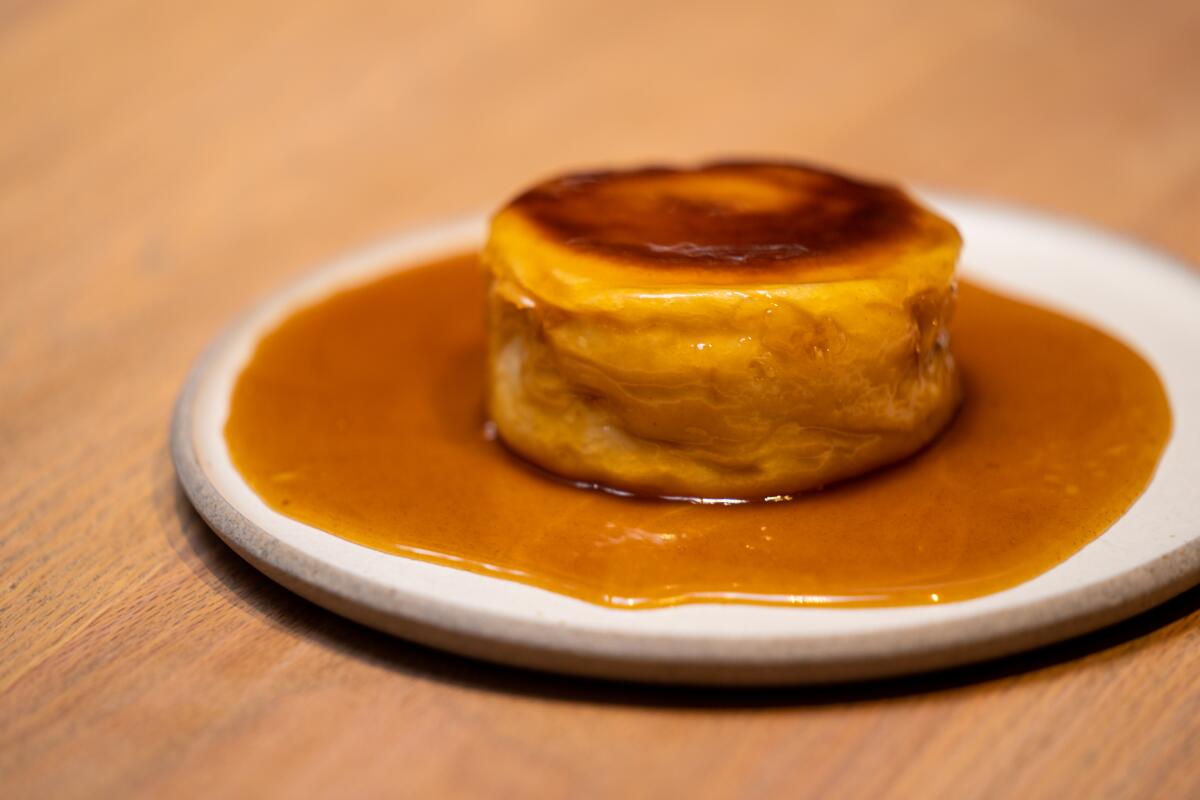
Pan-Roasted Honey Butter Brioche
2 hours, plus 3 days proofing. Makes 1 dozen.
The technique above, which is revolutionary and satisfying to execute, requires serving the brioche right away and works best if you’re making just one to four at a time simultaneously. I found the ideal balance to be doing a few on the stovetop to eat right away, then baking the remaining dough balls for the most delicious rolls to enjoy anytime with or without the honey butter. Or, you can skip the honey-butter and simply tuck all the dough into a pan for a unique brioche-meets-sourdough loaf.
Brioche
- 1 cup plus 1 ½ tablespoons salted butter (250 grams), preferably cultured high-fat
- 2 ½ cups all-purpose flour (333 grams)
- ¼ cup granulated sugar (50 grams)
- 1 envelope active dry yeast (7 grams) or 20 grams fresh cake yeast
- 5 large eggs (250 grams), room temperature
Honey-Butter
- 2 ¼ pounds unsalted butter (1,026 grams)
- 2 cups honey (680 grams), preferably light amber in color
1. Make the brioche: Take the butter out of the refrigerator and cut into tablespoons. Place on a plate in a single layer to soften. When you press into a piece, it should yield to pressure like Play-Doh. Use some more butter to lightly butter a large container or bowl.
2. While the butter softens, combine the flour and sugar in the bowl of a stand mixer fitted with the dough hook. Sprinkle the dried yeast or crumble the fresh yeast on top, then add 2 eggs. Beat on low speed until the dry ingredients are moistened, scraping the bowl if needed. Continue mixing while adding the remaining 3 eggs one at a time. Scrape the bowl and raise the speed to medium-high. Continue beating until the wet dough flaps against the side of the bowl, about 5 minutes. The dough will still look broken and cling to the sides of the bowl at this point.
3. Pick up a piece of butter, smash it a little between your fingers, then toss it into the mixer while the hook beats on medium-high speed. When it completely disappears into the dough, add another piece in the same way. Keep going until all the butter is incorporated. This will take about 10 minutes total. (The mixer may jump on your counter with the force of the beating during the process, so you may need to hold the machine steady with one hand while adding the butter with the other.) The machine’s beating will heat up the dough, but the butter will help cool it down to prevent it from breaking. The dough is done when it’s smooth, shiny and stretchy. If you hook a finger into the dough and pull, it should hang like Silly Putty. Don’t overbeat or the dough may break.
4. Remove the hook and use your hands to scoop the dough out of the bowl. Holding it over your work surface, pass it back and forth between your hands, gathering the sides under until the dough is very smooth on top. Lay it in the buttered container and gently press a piece of plastic wrap directly on the dough so it doesn’t form a skim, then cover the container with a lid or another sheet of plastic wrap stretched taut. Let proof at room temperature for 1 hour then transfer to the refrigerator for 12 hours.
5. Cut 12 pieces of wax or parchment paper into 5-inch squares. Generously butter one side of each square. Remove the dough from the refrigerator, uncover, and, pressing a bench scraper or sharp knife straight down into the dough, cut into 12 even pieces (about 74 grams each if you’ve got a scale).
6. Holding a piece of dough with both hands, flatten it slightly, then pull the edges under to form a tight ball. Put the ball in one palm, then cup your other hand around the ball and rotate that hand to tighten the ball further while giving it a perfectly round shape. The dough will be sticky, but don’t flour your hands or the dough. Transfer the ball to a buttered paper square, top side up. Repeat with the remaining dough. Arrange the balls on a sheet pan, spacing an inch apart. Drape a sheet of plastic wrap gently over the pan and let the dough proof at room temperature for 3 hours. Cover the pan from edge to edge loosely with plastic wrap, then refrigerate for 12 hours.
7. Remove the pan from the refrigerator and remove the outer sheet of plastic wrap. Let proof at room temperature for 3 hours.
8. To pan-roast in honey-butter, follow these instructions for cooking 1 roll. You can cook up to 4 rolls at a time, using a small skillet for 1 roll, a medium skillet for 2 rolls or a large skillet for 4 rolls. Increase the butter and honey proportionally: Use 6 tablespoons (3 ounces) butter and 2 tablespoons plus 2 teaspoons (2 ounces) honey per roll. Melt the butter and honey together in a skillet over medium heat, stirring occasionally. When the mixture starts to bubble, set a 4-inch-round, 2-inch high ring mold in the center of the skillet. Turn the heat to low, then cup one hand over a risen dough round and gently invert the dough into that hand and carefully peel off the paper with the other hand. Gently tip the dough into the center of the ring, tucking it in if needed.
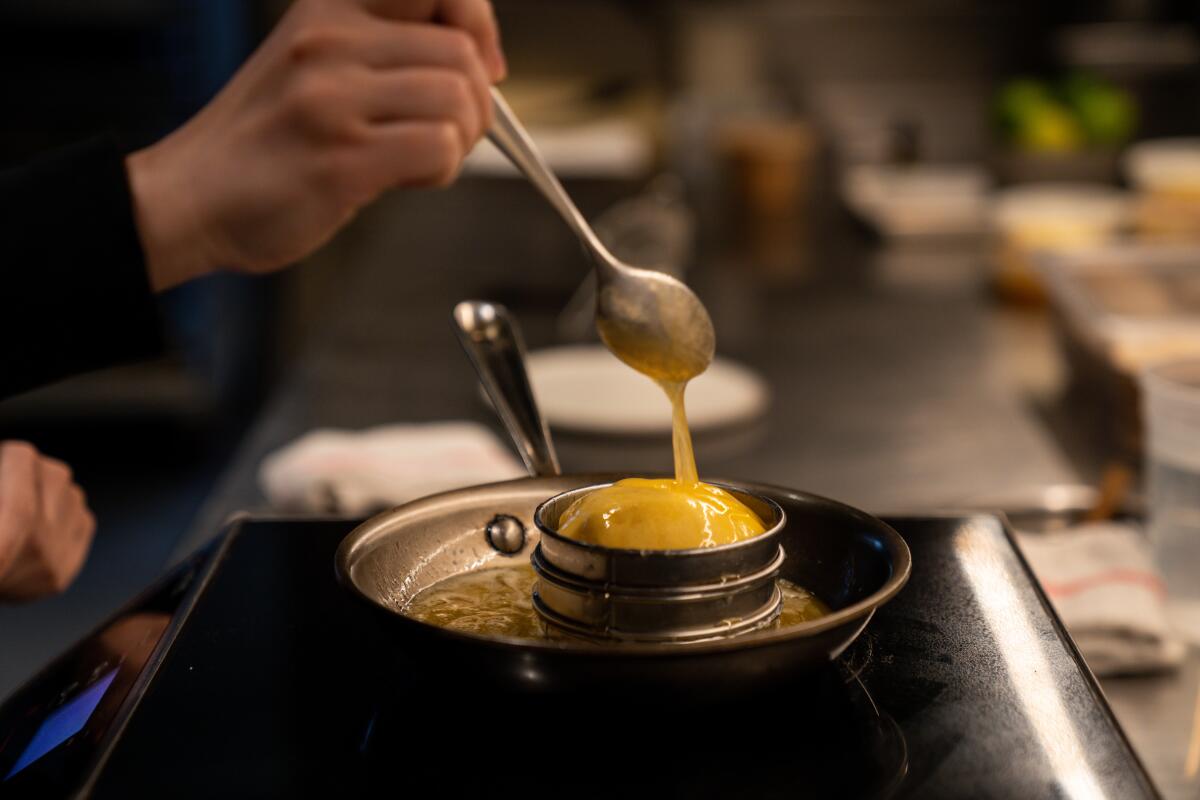
9. Set a timer for 9 minutes. Start spooning the honey butter over the dough and continue basting it for 30 seconds. If any air bubbles appear, gently pop them. Take a break, then go back to basting now and then, swirling the mold in the pan while basting to ensure the dough doesn’t stick.
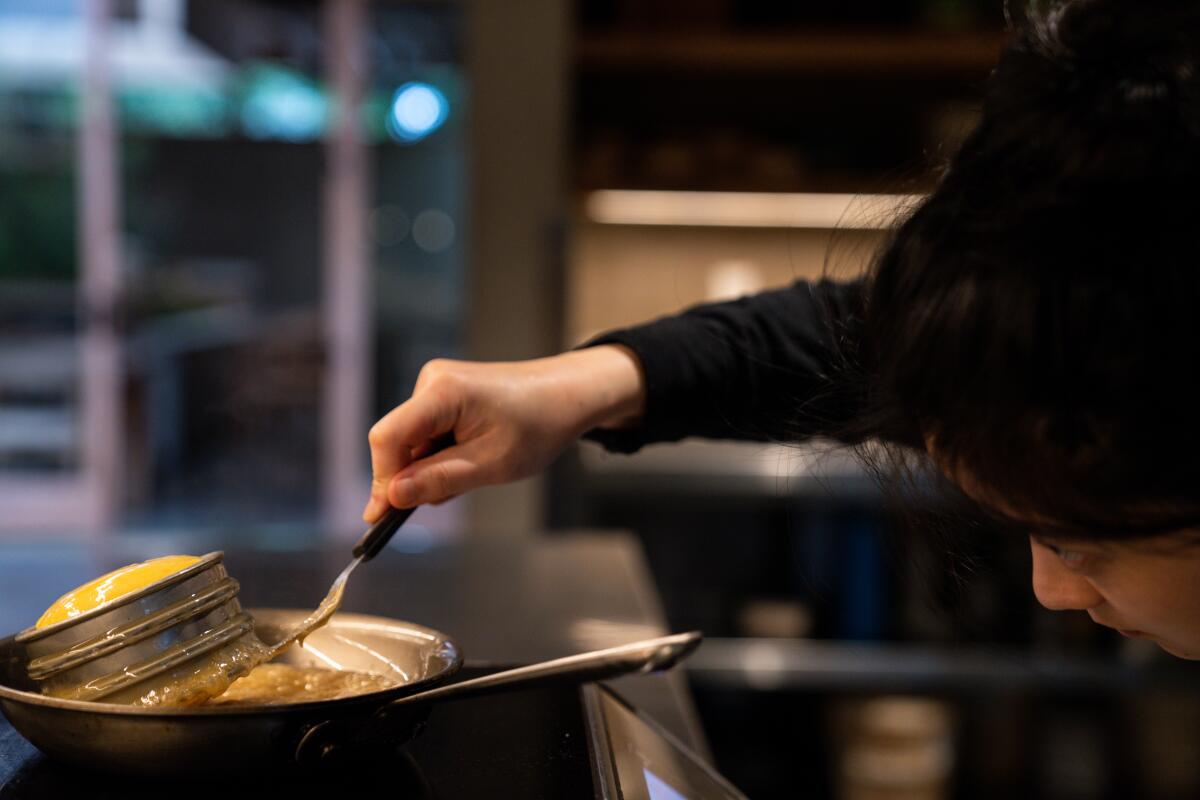
10. When the timer goes off, very carefully slide a spatula or bench scraper under the dough and ring mold and flip both together back into the pan. Set the timer for 9 minutes again. Baste for 30 seconds, then take a break. Baste the dough and swirl the mold in the pan every once in a while.
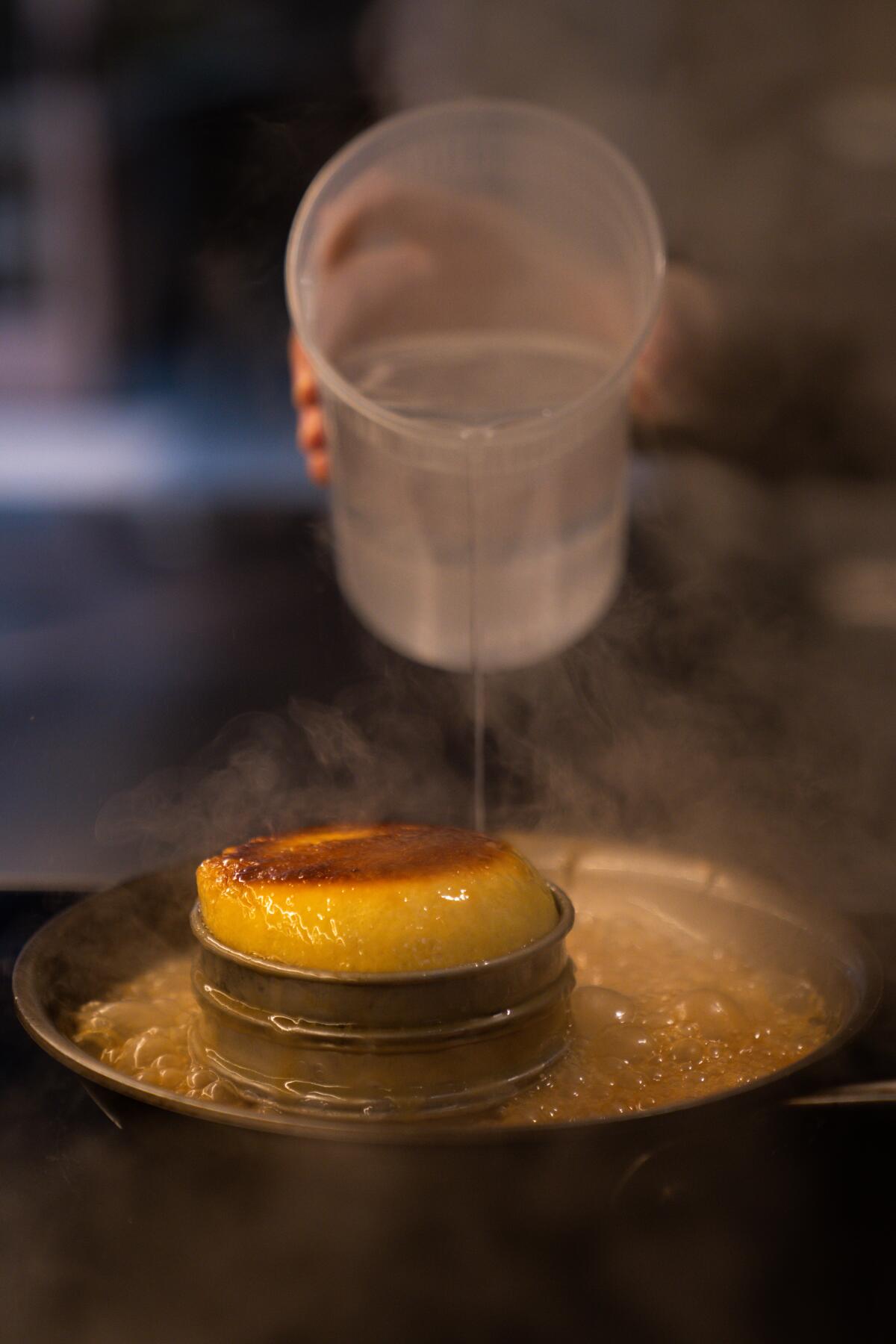
11. Turn the heat to high and set the timer for 3 ½ minutes. The honey butter will begin to bubble rapidly and start to caramelize. Use a small offset spatula to push and slide the bread in the ring mold around the pan to evenly caramelize the bottom. When the bottom of the bread is dark golden brown, after about 1 ½ minutes, carefully slide the spatula under the dough and ring mold and flip it over. Reduce the heat to medium as the caramel takes on a dark brown color and add 3 tablespoons water to the caramel to prevent it from burning. Continue pushing and sliding the ring mold around the pan with the spatula and add more water if the caramel starts to darken or thicken too much. It should be the consistency of maple syrup.
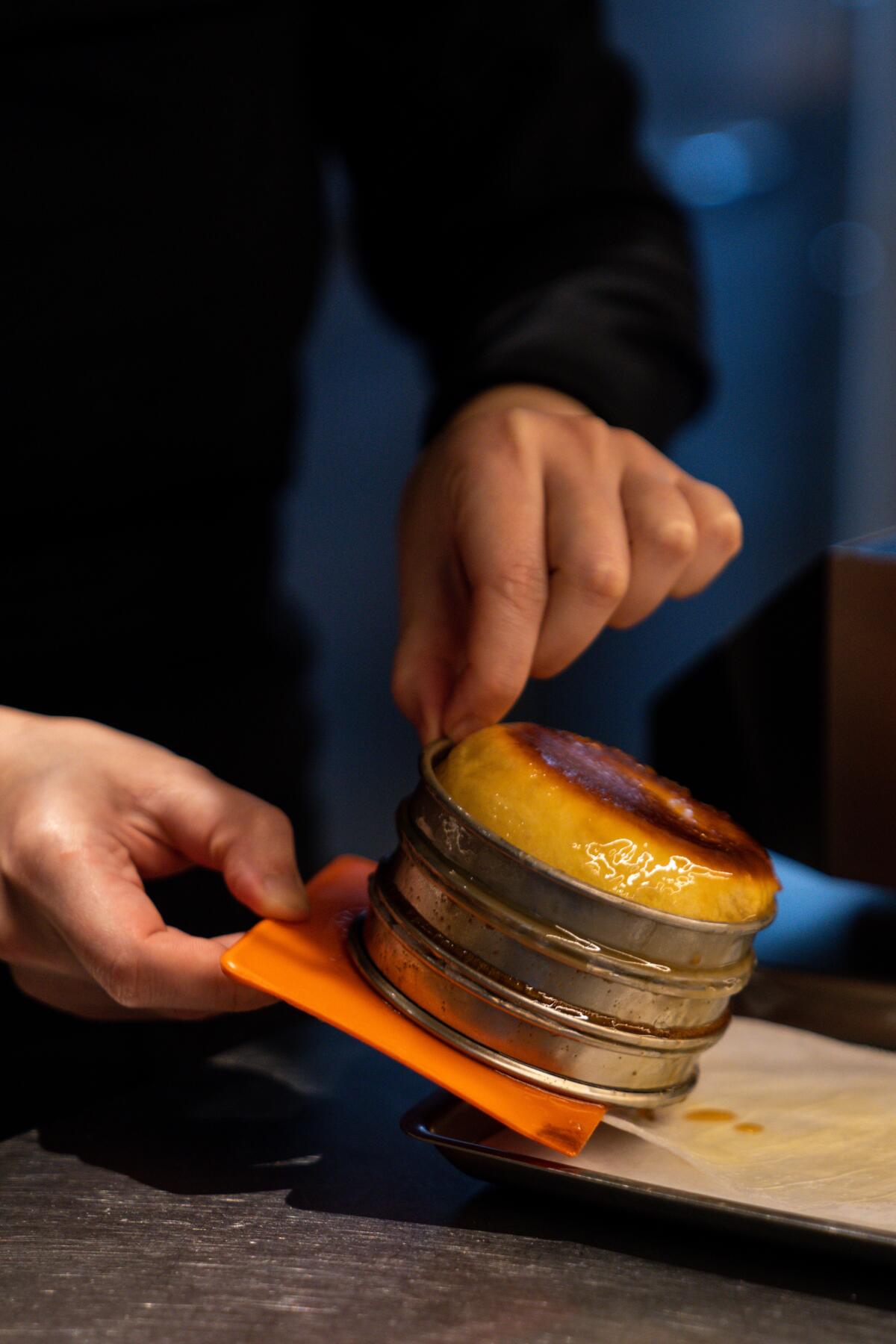
12. When the timer goes off, slide a spatula or bench scraper under the ring mold and dough and lift the bread out of the pan and flip onto a wax or parchment paper-lined pan. Let cool for a minute, then slide the small offset spatula between the bread and ring mold to release the bread while lifting off the mold.
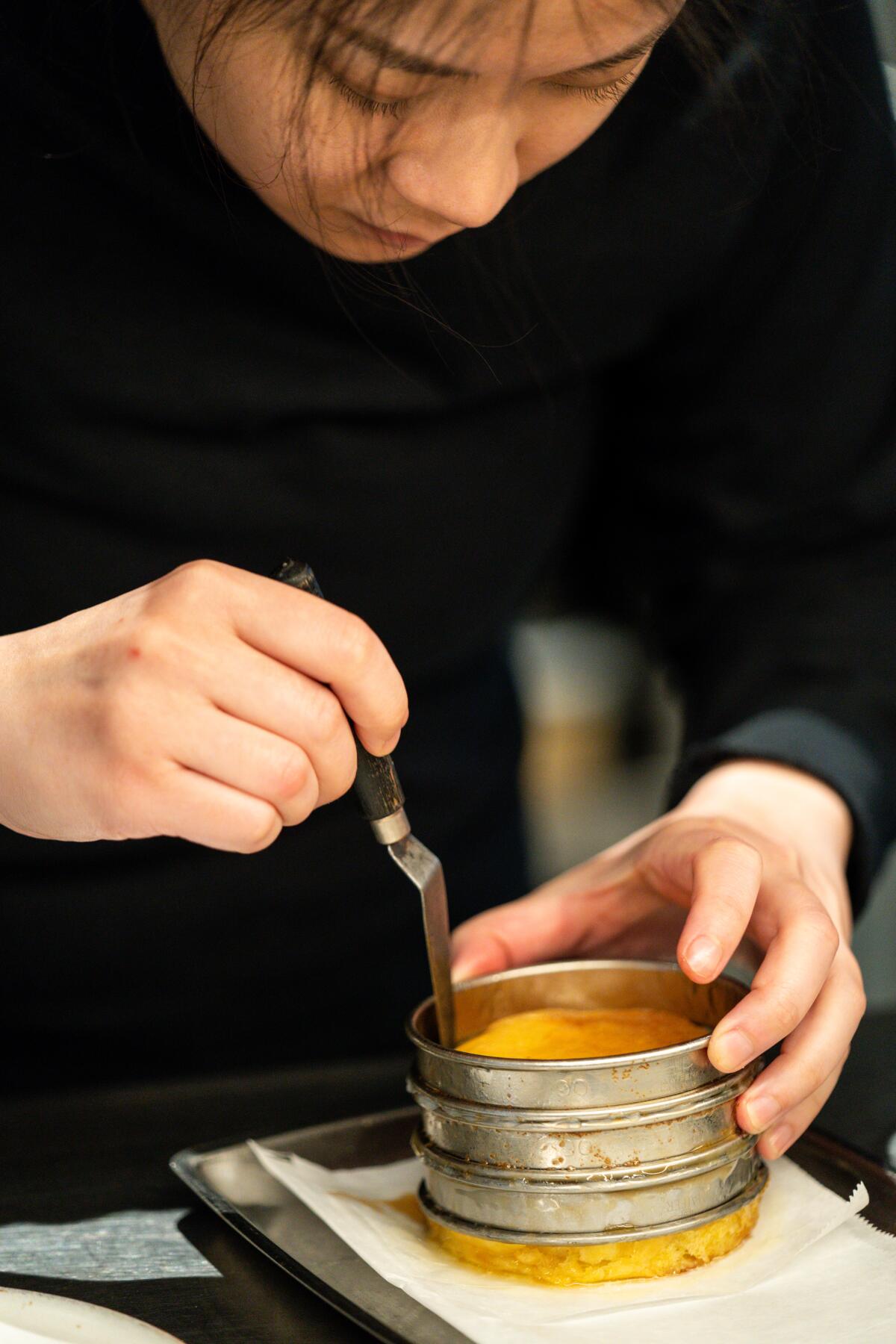
13. Transfer the bread to a serving dish. Pour the hot caramel sauce through a fine-mesh sieve set over a cup with a spout, then immediately pour the sauce over the bread. Serve hot. Repeat with the remaining bread dough balls, butter, and honey.
Or, try one of the variations below:
Baked Brioche Rolls
Heat the oven to 350 degrees. After the dough rounds have finished proofing in step 7, uncover the pan. Bake until light golden brown and an instant-read thermometer inserted in the center of one through the bottom registers 190 degrees, about 15 minutes.
Meanwhile, divide the honey butter ingredients between two large skillets. Melt over medium heat, stirring occasionally. Continue cooking until caramelized to a light golden brown, then carefully transfer the hot buns to the pans, dividing evenly. Spoon the honey butter over the buns until well-glazed on top and dark golden brown on the bottom, 3 to 5 minutes.
Divide the buns among serving plates. Pour the hot caramel sauce through a fine-mesh sieve set over a cup with a spout, then immediately pour the sauce over the buns. Serve hot.
Brioche Loaf
Butter a 9- by 5-inch loaf pan. After the dough has chilled in step 4, transfer to a clean work surface and press into a 9-inch-wide by 6-inch-long rectangle. Roll the rectangle along its length in three turns, then press the seam shut. Center the roll in the pan seam side down. Cover loosely with plastic wrap and let proof at room temperature for 3 hours, then refrigerate for 12 hours.
Remove the pan from the refrigerator. Let proof at room temperature for 4 hours, then remove the plastic wrap.
Heat the oven to 350 degrees. Bake until golden brown and an instant-read thermometer registers 190 degrees, 30 to 35 minutes. Unmold the brioche onto a wire rack. You can cool it and enjoy it plain at this point or glaze it with honey butter while it’s warm.
If you want to glaze the loaf, melt 6 ounces butter and 4 ounces honey in a medium skillet over medium heat. Melt, stirring occasionally, then continue cooking until dark caramel in color and thick. Slowly pour it over the warm loaf to coat. Serve warm.
Make Ahead
The unglazed baked brioche loaf and rolls can be tightly wrapped in plastic wrap and stored at room temperature for up to 1 day or in the freezer for up to 3 months. Thaw if frozen and, in both cases, refresh in a toaster oven or hot oven to serve warm.
Click here or below for the recipe card and to see videos of the process in action.
Pan-Roasted Honey Brioche
More to Read
Eat your way across L.A.
Get our weekly Tasting Notes newsletter for reviews, news and more.
You may occasionally receive promotional content from the Los Angeles Times.



